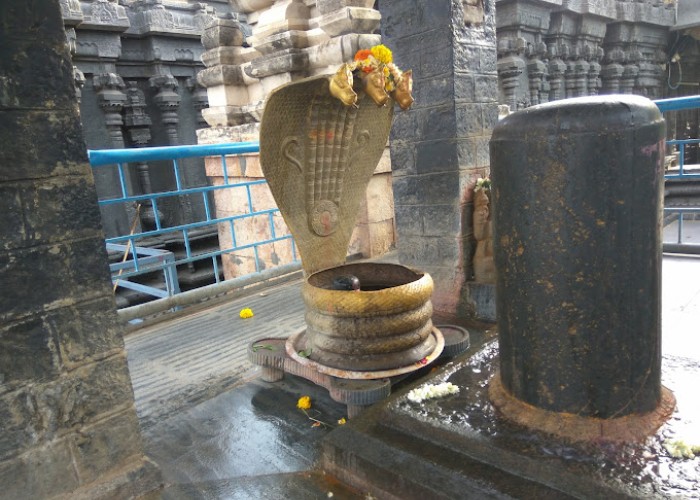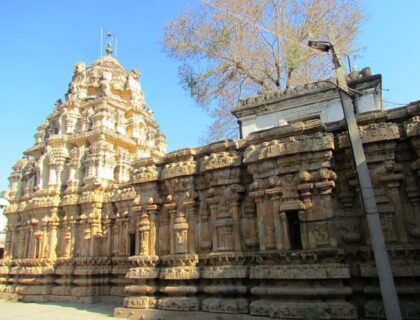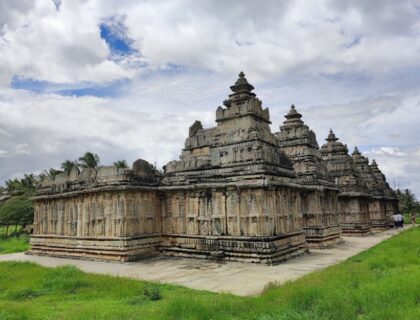Bugga Ramalingeswara Temple Tadipatri
Bugga Ramalingeswara Temple dedicated to lord shiva is located on the south bank of the Penna River in Tadipatri, Anantapur District, Andhra Pradesh. The Bugga Ramalingeswara Swamy temple was built in all architectural splendour during the Saluva dynasty’s reign in the Vijayanagara kingdom. According to the scriptures, the temple was built on the same site where Sage Parasurama lived and meditated. The presiding deity is a linga, believed to be Swayambhu. The temple has seven small independent pillars in front of the Vishnu shrine, which produce saptaswara when struck. Architectural historian James Anderson described the temple’s unfinished gopurams as wonders.
The Bugga Ramalingeswara Temple was built between 1490 and 1509 by Ramalinga Nayudu, a chieftain of the Gutti-Gandikota region, during the reign of the illustrious Vijayanagara Empire. It stands as a testament to the region’s rich cultural and architectural heritage. The temple, dedicated to Lord Shiva as Ramalingeswara Swamy, exudes architectural splendour with its unique blend of Chalukyan, Chola, and Vijayanagar art styles. According to records, the temple was designed by a Benaras-based sculptor named Yellanchari.
Bugga Ramalingeswara Temple is notable for the presence of a perennial underground stream that always flows into the Garbha Griha at the exact location where the Lingam is revered. The Lingam is believed to be Swayambhu (self-manifested). On the temple’s walls, the entire Shiva Purana is delicately carved and elaborately explained. Also, some sculptures depict scenes from the Ramayana and Mahabharata.
Story/Legend of Bugga Ramalingeswara Temple Tadipatri
According to Tadipatri Kaifiyat, collected by Col Mackenzie in 1802, “When Ramalinga’s cows were taken to graze in the fields, one of them would empty its milk on an ant hill. The cowherd threw an axe at the ant-hill. Ramalinga has a dream in which the Lord tells him that the cowherd has harmed him. According to the Tadapatri kaifiyat, Ramalinga was asked to build a temple on the spot.

True to the story, the presiding deity, the Linga, is unhewn and a’swayambhu’ (naturally occurring or self-originated). The Linga was consecrated at a small perpetual spring called ‘Bugga’ in local parlance, and the temple became known as the ‘Bugga Ramalingeswara Swamy’ temple.

The main sanctum contains the swayambhu linga, a naturally occurring symbol of Lord Shiva that continuously emits holy water, which is thought to bestow infinite blessings on those who consume it. A goddess statue stands adjacent to the temple, on the banks of the Penna River. According to legend, when the river’s water level reaches the navel point of the goddess statue, the entire town of Tadipatri will be submerged—a belief rooted in local folklore and spirituality.
History of Bugga Ramalingeswara Temple Tadipatri
Bugga Ramalingeswara Temple is 4 kilometres from Tadipatri Railway Station. It was most likely constructed between 1490 and 1509 during the reign of the Vijayanagara Empire. According to Colin Mackenzie’s Tadipatri kaifiyat from 1802, Ramalinga Nayudu, a chieftain from the Gutti-Gandikota region of the Vijayanagara Empire, built the temple.

Bugga Ramalingeswara Temple is unique in that it has an underwater stream running through it. The water is said to have never dried up, regardless of the season, and the Shivlinga in the temple is always surrounded by water. It is also said that the temple was built on the exact spot where Sage or Guru Parasurama lived and meditated for many years.

Bugga Ramalingeswara Temple was built in various architectural styles, including Chalukyan, Vijayanagara, and Chola. The temple was built by Ramalinga Naidu, the Vijayanagaram Kings’ chieftain. In the 16th century, he built the temple, which now houses sculptures, paintings, and stone carvings.
The architecture of Bugga Ramalingeswara Temple Tadipatri
Bugga Ramalingeswara Temple is spread over several acres at the eastern end of Tadapatri town, on the banks of the Penna River, and is distinguished by its massive gopurams on three sides of the temple, north, west, and south.

The temple’s architecture combines Chalukyan, Chola, and Vijayanagar art. The temple has two main entrances: south and west. Vijayanagar kings built the temple’s western, northern, and southern gopurams. The north gopuram, while unfinished, has the most elaborate sculpture with intricate carvings. The entire Shiva Purana is carved on the temple walls in miniature with intricate details. The walls are also carved with scenes from the Hindu epics Ramayana and Mahabharata. This temple features a miniature stone chariot similar to the famous chariot of the Vittala Temple in Hampi.

The main sanctum contains the swayambhu linga, a naturally occurring symbol of Lord Shiva that continuously emits holy water, which is thought to bestow infinite blessings on those who consume it. A goddess statue stands adjacent to the temple, on the banks of the Penna River. According to legend, when the river’s water level reaches the navel point of the goddess statue, the entire town of Tadipatri will be submerged—a belief rooted in local folklore and spirituality.
Facts about Bugga Ramalingeswara Temple Tadipatri
- Bugga Ramalingeswara Swamy Temple is located on the banks of the Penna River in Tadipatri, Anantapur district, Andhra Pradesh.
- The temple got its name from a perennial underground stream (Bugga in Telugu) that flows into the sanctum sanctorum at the location where the Lingam is consecrated.
- In the 16th century, Ramalinga Nayudu, a Vijayanagara Kings chieftain, built the Sri Bugga Ramalingeswara Swamy temple.
- According to the records, a sculptor named Yellanchari was brought from Benaras to help build the temple.
- According to legend, the temple was built on the site where sage Parasurama once lived and meditated.
- The Bugga Ramalingeswara temple is one of the few temples whose exact construction dates are known.
- The Bugga Ramalingeswara Swamy Temple’s main sanctum sanctorum contains two lingams, which is one of its distinguishing features.
- One of the lingams is thought to represent Lord Ramalingeswara, the other his consort, Goddess Parvati.
- These gopurams and carvings in the temple depict Lord Shiva’s various avatars (Kevalamurti, Dakshinamurti, Uma Maheshwaramurti, Vrishabaruda murti, Natarajamurti, Ardhanarimurti, and even the Haryadhra Murti) and life stories.
- The Bugga Ramalingeswara Swamy temple is well-known among tourists and devotees alike because the scriptures of the Ramayana and Mahabharata are carved into the temple’s walls.
- The main temple structure is built in the Vijayanagara architectural style, with intricate carvings and sculptures.
- The large temple complex contains several smaller shrines dedicated to other deities, such as Lord Ganesha, Goddess Parvati, and Lord Subramanya.
Festivals In Bugga Ramalingeswara Temple Tadipatri
- Mahashivratri: Lord Shiva is the subject of this festival. Many devotees hold the belief that he is the Adi guru, the Yogi tradition’s founder. It is seen by recalling Shiva and reciting petitions, fasting, doing Yoga as well as thinking.
- Deepawali – This festival is celebrated with great enthusiasm and happiness. Many visit this temple during this great festival.
- Navarathri – All ten days of Navarathri are celebrated with great reverence.
- Other important festivals include Hanuman Jayanthi, Sri Rama Navami, Ugadi, and Makar Sankranti.
Best Time to Visit Bugga Ramalingeswara Temple Tadipatri
This place is heavenly and spiritual; you can visit it all year. However, the best time to visit this temple is during the monsoon and winter seasons. During the monsoon season, this location receives moderate to heavy rainfall, making it appear heavenly with its greenery and bringing freshness elsewhere.
How To reach Bugga Ramalingeswara Temple Tadipatri
By Air: The nearest airport is Kadapa Airport in Andhra Pradesh, which is 110 km away.
By Rail: Bugga Ramalingeswara Temple Tadipatri is 4 km from Tadipatri railway station in Andhra Pradesh and 58 km from Anantapur.
By Road: APRSTC Bus Station in Tadipatri is 1.6 km Away From the temple. Taxis and car rentals are also available to take you to the temple from there.
Also Read – Mundeshwari Temple Kaimur
Support Us
If our content helps you even 1% in gaining information about the temple, please support us by contributing any amount, our UPI ID is - q417999792@ybl Or pay using QR CODE >>> Click Now
Location
Facilities
- Drinking Water
- Pooja Item Shops
- Prasad Shops
- Restaurants Nearby
- Resting Room









































